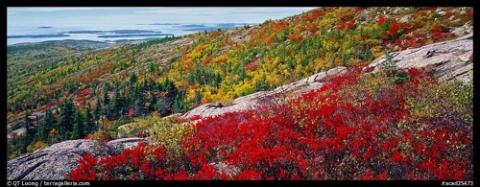We're planning a special fall-in-the-parks series, and we'd like your input on our story line-up. While we've got the obvious parks covered -- Great Smoky, Shenandoah, Grand Teton, etc -- what national park do you think should definitely get some attention for a fall visit?
The park that gets the most mentions will be added to the to-do list. And keep in mind that we're fairly good with the obvious choices. What we need your help with is the unusual! So, tell us which one, and why, and we'll put our scribes to it.
And feel free to mention lodges, too. Again, we know most of the renowned places, but would love to write about some off-the-beaten-path national park accommodation that is truly wonderful in the fall.




Comments
Ozark National Scenic Riverways for sure. What could be better than spending a day paddling downriver or visiting springs, surrounded by bluffs full of brilliant orange, red, and yellow trees?
eg, Big Spring in fall: http://www.nps.gov/ozar//images/20080305120341.jpg
Kurt's re-posting of his very informative "Traveler's Checklist: Acadia National Park (Sept. 14,2009) provides a wonderful overview of the only national park in the Northeast. Acadia, "Where The Forest Meets The Sea," is easy to traverse because of its compact size. Since most of the park was once privately owned - Acadia owes its existence primarily to the dedication and philanthropy of wealthy private citizens such as John D. Rockefeller, Jr, Charles W. Eliot and George B. Doerr - visitors find themselves driving in and out of the park in their travels. Thus, you have access to the scenic beauty of the park while never being far from the ammenities of one of the quaint villages and towns that dot Mount Desert Island.
The Fall is perhaps the most beautiful time of the year here. Days are warm and bright, while nights are cool, clear and starry. The 27-mile Park Loop Road winds along the rocky coastline with frequent turnouts for viewing the spectacular scenery such as Sand Beach, Thunder Hole and Otter Cliff (on a clear day, you can see the Schoodic Peninsula, a part of the park that is located on the mainland), where the road turns inland through the park's woodland and mountain interior, past Jordan Pond (Don't forget Kurt's suggestion to stop for the traditional popovers and tea, while viewing Eagle Lake and The Bubbles, a rounded glacial feature. Lobster dinners, of course, are available, but prices are considerably cheaper if you visit one of the many lobster pounds on the island).
Continuing further, a drive up Cadillac Mountain (1,5300-feet) provides a spectacular view of Frenchman's Bay and the Porcupine Islands. For a closer look take a schooner cruise or a ranger-naturalist led boat cruise from Bar Harbor to view eagles, osprey, harbor seals and numerous seabirds. Cadillac Mountain offers an opportunity to be one of the first to view the sunrise or sunset on the mainland of North America! Since Acadia is located along the Atlantic Flyway, the park is an excellent place to view the fall migrations (so bring a pair of binoculars with you). Or join park rangers and volunteers for the daily HawkWatch. Kurt mentioned the Night Sky Festival (September 17-21), but if you decided to visit the summit for a glorious sunset. After many of the other visitors have left, stay around to view the starry skies. With no densely populated urban centers within a day's drive, the stars and constellations of the Milky Way are easily seen.
And don't hesitate to get off the main roads for some quiet solitude. Whether by hiking, walking, bicycling or horse-drawn carriage. Rockefeller had an aversion to the newly-invented, noisy automobile to the island, so he build a system of gently-graded carriage roads lined with broken stone and a series of beautiful stone bridges crisscrossing his property to offer a refuge from the "horseless carrage"and encourage the use of horse-drawn carriages for transportation. They lead to some of the most spectacular vistas in the park and a're still off limits to automobiles!
There are hikes for Acadian visitors of all abilities and fitness levels - whether it be a leisurely storll or a strenuous hike. One of the most spectacular is the Precipice Trail. It's the shortest in the park - straight up! While the "Beaver Log", the park's official newspaper, advertises it as "not for the faint-of-heart," it is challenging without being overly strenuous. Metal railings and ladders, installed in the 1930's as part of the high-quality trail work done by the CCC, assist the hiker/climber.
The Ranger-Natualist Program (also posted in the "Beaver Log") runs until mid-October and offers a wide range of activities. Take advantage of the walks, talks, hikes, cruises, evening campfire programs (at the two campgrounds) and do start your visit by stopping at the Hull's Cove Visitor Center.
Finally, the picture at the top of this article shows the fall foliage from the top of Cadillac Mountain. However, more vivid colors are found in the woods and alog the shores of ponds and streams in lower elevations.
Acadia certainly offers somthing for everyone. So, enjoy the essence of Acadia. But please leave it the way you found it. We sure like it the way it is!!!
You could visit Lake Mead NRA. The weather is lovely in October, the hiking is getting great and you would get a chance to see the newly finished Mike O'Callaghan-Pat Tillman bridge. Its a sight not to be missed. If you want to get out on the lake, take a cruise on the Desert Prince Cruise. There is a lot of things to do once the temperatures drop!
Gauley NRA has its dam-release days in the Fall, making it a mecca for white-water rafters...
Any of the Southern Utah parks, for sure. And I think I already saw a vote up there for Guadalupe Mountains NP, which I will second!